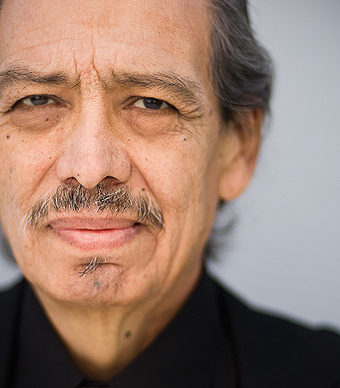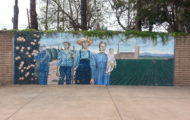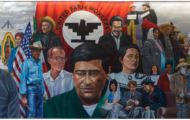Emigdio Vasquez
Emigdio Vasquez (1939-2014) was born in Jerome, Arizona, to Mexican immigrant parents. In 1941, his family moved to Orange, California, where he attended Mater Dei High School and Orange High School. Interested in art from a young age, Vasquez took art classes and created his own comic books based on the stories of the Mexican Revolution told by his father.
Vasquez obtained his Associate of Arts degree at Santa Ana College in 1973 and obtained both his Bachelor (1978) and Master of Arts (1979) degrees at California State University, Fullerton. His thesis project was an 85-by-65-foot mural depicting the Chicano working class, with figures modeled on his father and other workers. Influenced by Mexican muralist Diego Rivera, as well as the Dutch painter Rembrandt, Vasquez utilized a social realist style to depict Chicano life and culture. Vasquez considered his art “to be a part of the experience of the working class. The daily life of people in the barrio are documented in my work . . . I want to convey to the viewer the intense reality which people experience.”
For roughly 40 years, Vasquez painted dozens of murals across Orange County, including Disneyland, Anaheim City Hall, the Orange County Transportation Center, the Fullerton Museum, Cal State Fullerton, and Santa Ana College. He managed art programs for City of Santa Ana and the California Arts Council, and was an artist-in-residence at the Bowers Museum of Cultural Art from 1985 to 1988. In 2013, Vasquez became the first Orange County resident awarded the Maestro award from the Latino Arts Network.
Vasquez died on August 9, 2014, in Newport Beach, California at age 75. Often called the “Godfather of Chicano Artists” in Orange County, Vasquez’s artworks continue to vividly illustrate the shared identity of the Chicano/Chicana community.
Sources:
1. “Emigdio Vasquez Brochure,” UC Santa Barbara Library.
2. Alejandra Molina, “Renowned muralist Emigdio Vasquez dies,” The Orange County Register, August 14, 2014.
3. John Rogers, “Emigdio Vasquez, pioneer in Chicano art movement, dies at 75,” The Washington Post, August 14, 2014.
1987
Chicano Gothic
Chicano Gothic is a 6 ft. x 20 ft. acrylic-on-cement mural located in the enclosed outdoor swimming pool area in Memorial Park, depicting the Orange County Chicano/Chicana working class in their dominant industries. On the far left, an elderly man represents the fruit pickers in the citrus groves, and to his right a younger worker holds a hammer, perhaps as a factory worker or craftsman. In the center, a farmer stands next to his wife and young child. Behind is a lush green field where workers are bent over as they tend to it, and a large factory protrudes from the background as its large tower omits a plume of dark gray smoke that covers the sky. On the far right, a small house rests in front of the Santa Ana Mountains.
The name “Chicano Gothic” and the portrait-like image of the farmer and his wife mimic Grant Wood’s iconic 1930 painting American Gothic. Like Wood's painting, the subjects of Vasquez’s Chicano Gothic have long, somber faces. In American Gothic, the man stands to the right and in front of the woman; however, in Vasquez's mural the woman stands on the right and side-by-side with the man, suggesting a disruption of traditional American gender roles.
The workers’ humble blue clothing represents the blue-collar Chicano/Chicana working class, and Chicano Gothic is one of several murals that nods to Vasquez’s socialist ideology. Influenced by the contemporary realism movement, Vasquez sought to portray the working class not as idealized subjects, but as realistic portraits of the blue-collar Chicano/Chicana community in Orange County.
However, the mural is also critical and satirical interpretation of American and Chicano culture. Vasquez was very critical of the predominantly white class that controlled the low wages and poor working conditions of the working class. He vehemently defended the blue-collar Chicanos/Chicanas, and Chicana Gothic shows the proud, hardworking, family-centered attitudes of his community. By doing so, Vasquez counters the kind of traditional image seen Wood’s American Gothic, subverting American mainstream culture by celebrating Chicano culture.
1997
The Legacy of Cesar Chavez
Designed by internationally known artist and muralist, Emigdio Vasquez, The Legacy of Cesar Chavez mural was produced exclusively for Santa Ana College. The mural is a continuation of Vasquez’s many works that depict the urban experience of working class Chicanos. Through this art and others, Vasquez aims to convey a powerful sense of the human struggle for dignity within the Hispanic experience of 20th and 21st century America. Of the many murals he has created, Vasquez considers The Legacy of Cesar Chavez his favorite.
"As a tribute to Cesar Chavez, I wanted to paint a heroic and poignant mural that would celebrate his life. I have depicted Cesar Chavez surrounded by some of his compatriots in the farm workers movement, like Dolores Huerta, Luis Valdez, and Fred Ross. Just as important, however, I decided to include anonymous images of people from the working class, the people loved by Cesar Chavez. He adhered to the ideal that working people are not beasts of burden, but are human beings deserving of respect, dignity, and social justice. Cesar Chavez dedicated his life to this ideal, he engaged in a ferocious struggle to improve the lives of the campesinos who toil in the fields. His struggles and accomplishments leave an important legacy that will forever be recorded in the annals of American Labor History. Cesar Chavez will be honored in history by his inclusion in that pantheon of heroes and martyrs of the American working class."
-Emigdio Vasquez
Sources:
1. Sal Rojas, "Santa Ana College, Orange County. Mural by Emigdio Vasquez," BrownPride.com.




